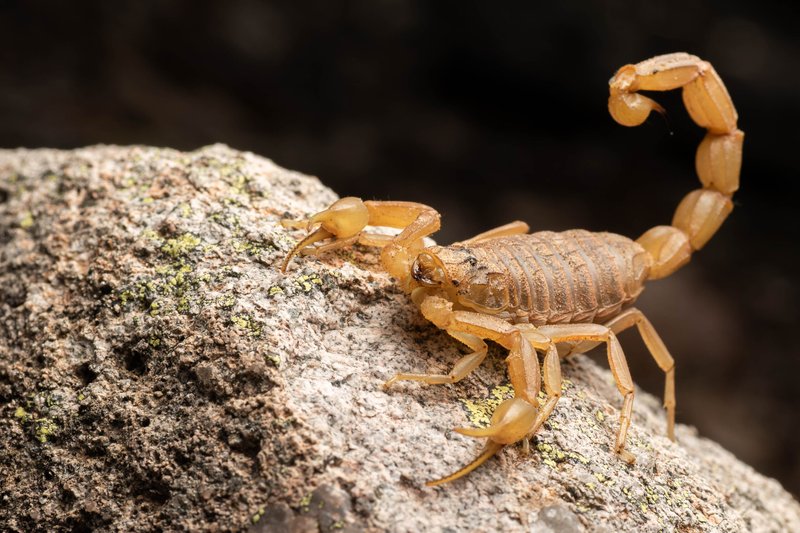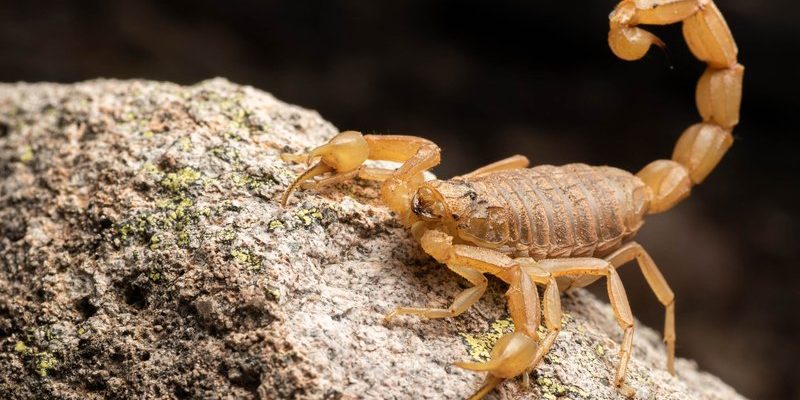
Have you ever wondered what it’s like to live in the world of scorpions? The bark scorpion, scientifically known as Centruroides sculpturatus, is one of the most fascinating and notorious members of this ancient group of arachnids. Found primarily in the southwestern United States and parts of Mexico, this little creature packs quite a punch—more than just a beautiful exterior. They are known for their slender bodies, distinctive coloration, and, yes, their notorious sting, which can lead to some serious medical concerns.
Imagine this: A tiny, golden-brown critter, often no more than three inches long, scuttling across your backyard. Their presence can invoke a blend of curiosity and fear. Yet, understanding bark scorpions can help you appreciate their role in the ecosystem. Like many creatures, they’re not just out to scare us. They play an essential part in controlling insect populations, making them valuable even in their sinister appearances.
Physical Characteristics of Bark Scorpions
The bark scorpion is a sight to behold, with its long, slender legs and an elongated tail that ends with a sharp stinger. Their bodies are usually a light tan or yellow color, helping them blend in with their natural environment. This camouflage is not just for show; it plays a crucial role in their survival as it helps them avoid predators. The scorpion’s pincers are also relatively large compared to its body, giving it an imposing look despite its small size.
When we talk about size, most bark scorpions measure around three to four inches in length. Their tails, which are often curled over their bodies, can be quite a sight. Interestingly, while many might think that larger scorpions are inherently dangerous, bark scorpions are one of the most venomous species in North America, with a sting that is considered to be quite painful.
Coloration and Patterns
The coloration of the bark scorpion is one of its standout features. These scorpions can vary in shades from yellow-tan to brown, often exhibiting a pattern that helps them blend into the bark of trees—hence the name. This ability to camouflage is crucial for their hunting strategy. They primarily hunt insects at night, using their keen eyesight to detect movement in the dark. The patterns on their bodies serve not only as a disguise from predators but also help them remain undetected by their prey.
Habitat and Distribution
Bark scorpions prefer warm, dry environments, thriving in desert landscapes where they can hide among rocks, crevices, and, yes, tree bark. They are often found in urban areas, making their homes in gardens, woodpiles, and even inside homes when temperatures rise. This adaptability is key to their survival, as it allows them to coexist with humans and other animals.
Geographically, bark scorpions are prevalent in the southwestern United States, particularly in Arizona, where they are commonly spotted. Their range extends into Mexico, where similar habitats provide the perfect conditions for them to thrive. If you live in these areas, it’s essential to be aware of their presence, especially during warmer months when they are most active.
Bark Scorpions in Human Habitats
As mentioned, bark scorpions are often found near human dwellings. Their attraction to these habitats can be attributed to the availability of food sources like insects. This can lead to unwanted encounters, especially if not careful. They usually come out at night, so spotting them in the daylight is uncommon, adding to the intrigue and sometimes fear surrounding them. In regions where they are prevalent, it is advisable to take precautions, such as keeping yards clean and sealing entry points in homes.
Diet and Hunting Behavior
Bark scorpions primarily feed on insects, which are abundant in their natural habitat. Their diet consists mainly of crickets, roaches, and other small arthropods. You might be surprised to learn that these creatures are quite efficient hunters. They employ a strategy that relies on stealth rather than speed. With their excellent vision, they can detect movements from a distance, allowing them to ambush their prey effectively.
When hunting, a bark scorpion will use its pincers to capture its prey swiftly, immobilizing it with a swift sting from its tail. Once the insect is subdued, the scorpion uses its powerful mouthparts to consume its meal. They can go for long periods without eating, thanks to their slow metabolism, which allows them to survive in harsh conditions where food might be scarce.
Adaptations for Survival
These scorpions have evolved several adaptations that enhance their survival in their often harsh environments. Their ability to tolerate dehydration is remarkable, allowing them to thrive in arid climates. Additionally, their nocturnal lifestyle helps them avoid the scorching heat of the day, reducing the risk of dehydration. The bark scorpion’s venom also plays a significant role in their survival, deterring potential predators and helping them catch prey, which is crucial in maintaining their ecological role.
Reproduction and Lifecycle
Bark scorpions have a fascinating reproductive cycle that sets them apart from many other insects. Mating typically occurs in the warmer months. The male engages in a courtship dance, where he grips the female’s pincers and leads her in a series of movements. This dance is quite delicate and requires a significant amount of energy. After mating, the female will produce a brood of live young, which is rather unique compared to other arthropods that lay eggs.
Once born, the young scorpions climb onto their mother’s back and remain there for several weeks, gaining protection and nourishment until they are ready to venture out on their own. This maternal care is quite rare in the insect world and underscores the bark scorpion’s adaptability and survival strategies. As they grow, they will molt several times, gaining size and strength before reaching adulthood in about one to two years.
Life Expectancy
In the wild, bark scorpions can live for several years, with lifespans typically ranging from three to five years. However, under ideal captive conditions, some have been known to live even longer. Their ability to withstand harsh conditions directly contributes to their longevity. By understanding their life cycle, we can better appreciate the ecological roles they play throughout their lifespans.
Venom and Its Effects
One of the most talked-about aspects of bark scorpions is their venom. While their sting is painful, it is rarely fatal to healthy adults. Bark scorpion venom contains a mix of neurotoxins that can affect the nervous system, leading to symptoms like intense pain, swelling, and, in some cases, systemic reactions. Children, the elderly, and individuals with compromised immune systems are particularly at risk, so it’s vital to seek medical attention if stung.
The effects of a sting can be likened to being bitten by a bee, causing immediate pain and discomfort. In most adults, the symptoms subside within a few hours, but for some, the reaction can be more severe, requiring medical intervention. Understanding the risks associated with bark scorpions is important, particularly for those living in areas where encounters are more likely.
First Aid for Bark Scorpion Stings
If you or someone you know gets stung by a bark scorpion, here are steps to take. First, stay calm. Avoid panicking, as this can exacerbate the situation. If symptoms appear mild, applying a cool compress to the sting site can help reduce swelling and alleviate pain. Over-the-counter pain relievers can also be effective.
However, if symptoms worsen or if the individual experiences difficulty breathing, seizures, or severe pain that doesn’t subside, seek medical attention immediately. In many areas, antivenom treatment is available and can be administered to those at high risk of severe reactions. Knowing how to respond to a bark scorpion sting can help ensure safety and peace of mind.
Conservation Status and Importance
Bark scorpions, like many other species, face threats from habitat destruction and climate change. These factors can disrupt their natural habitats, leading to declining populations. While they may not be on the endangered species list, preserving their habitats is crucial for maintaining ecological balance. They play a vital role in controlling insect populations, making them important contributors to their ecosystems.
Understanding and respecting their existence is essential. While they may seem dangerous, bark scorpions are a natural part of the environment and have a role to play. By educating ourselves about these fascinating creatures, we can promote coexistence and conservation efforts that benefit both humans and wildlife.
Final Thoughts
The bark scorpion is a remarkable creature with much to offer when viewed through a lens of curiosity rather than fear. Understanding their physical characteristics, habitat, diet, and behavior can help demystify these intriguing arachnids. They remind us of the complex web of life that exists all around us, highlighting the importance of every creature, no matter how small or seemingly fearsome.
FAQ
How dangerous is a bark scorpion sting?
A bark scorpion sting can be quite painful but is rarely fatal for healthy adults. The venom contains neurotoxins that can cause severe reactions, especially in children and the elderly. It’s essential to monitor symptoms and seek medical attention if necessary.
Where do bark scorpions live?
Bark scorpions are commonly found in the southwestern United States and Mexico. They prefer warm, dry habitats, often living in urban areas where they can find shelter and food sources like insects.
What do bark scorpions eat?
Bark scorpions primarily feed on insects such as crickets and roaches. They are efficient hunters, using their keen eyesight to detect prey at night.
How long do bark scorpions live?
In the wild, bark scorpions typically live for three to five years. Under optimal conditions in captivity, they can live longer, highlighting their ability to adapt and thrive in various environments.
Are bark scorpions beneficial to the ecosystem?
Yes, bark scorpions play a vital role in controlling insect populations, which helps maintain ecological balance. Their presence in the ecosystem is essential for food chains and pest control.
How can I prevent bark scorpions in my home?
To keep bark scorpions away, ensure your yard is clean and free of debris. Seal cracks and gaps in your home, and be cautious when moving items like wood piles where they might hide.
What should I do if I see a bark scorpion in my home?
If you spot a bark scorpion, it’s best to keep your distance. If possible, gently guide it outside using a container and cardboard. Avoid attempting to handle it, as it may feel threatened and sting.

